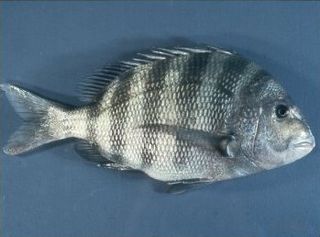
Archosargus probatocephalus, the sheepshead, sheepshead seabream or convict fish, is a species of marine ray-finned fish belonging to the family Sparidae, the seabreams and porgies. This species is found in the Western Atlantic Ocean. The sheepshead is an important species to recreational and commercial fisheries.

Sparidae is a family of ray-finned fishes belonging to the order Spariformes, the sea breams and porgies, although they were traditionally classified in the order Perciformes. They are found in shallow temperate and tropical waters around the world and are demersal carnivores.

Calamus is a genus of marine ray-finned fishes belonging to the family Sparidae, the seabreams and porgies. Most of the species in this genus are found in the Western Atlantic Ocean, with 2 species occurring in the Eastern Pacific Ocean.
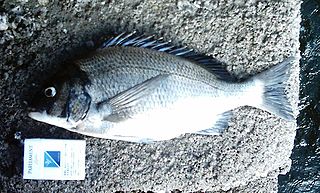
Acanthopagrus schlegelii, the blackhead seabream, black porgy or black seabream, is a species of marine ray-finned fish belonging to the family Sparidae, the seabreams and porgies. This species is found in the Western Pacific Ocean. The blackhead seabream is an important species in commercial fisheries, particularly in Vietnam.
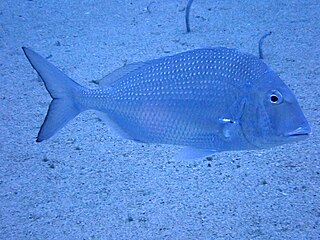
The sheepshead porgy, also known as the littlemouth porgy or speckled porgy, is a species of marine ray-finned fish belonging to the family Sparidae, the seabreams and porgies. This species is found in the Western Atlantic Ocean.
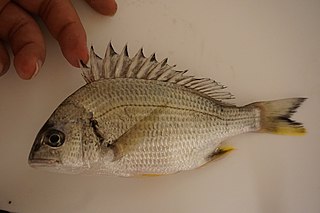
Acanthopagrus latus, the yellowfin seabream, grey bream, Houttuyn's yellowfin seabream, Japanese bream or yellow-finned black porgy, is a species of marine ray-finned fish belonging to the family Sparidae, the seabreams and porgies. This fish is found in the Western Pacific Ocean.

The littlehead porgy is a species of marine ray-finned fish belonging to the family Sparidae, the seabreams and porgies. It is only found in the western portion of the tropical Atlantic Ocean, where they are often caught and used as food.

Chrysoblephus gibbiceps, the red stumpnose, red stumpnose seabream or Miss Lucy, is a species of marine ray-finned fish belonging to the family Sparidae, the seabreams and porgies. This fish is endemic to the southwestern Indian Ocean off the coast of South Africa. The International Union for Conservation of Nature classifies this species as Endangered.

Archosargus is a genus of marine ray-finned fishes belonging to the family Sparidae, the sea breams and porgies. These fishes occur in the Western Atlantic and Eastern Pacific Oceans.
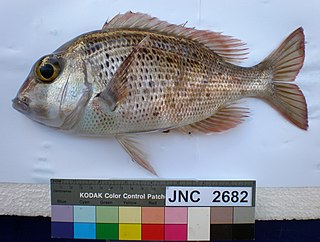
Gymnocranius is a genus of marine ray-finned fishes belonging to the family Lethrinidae, the emperors and emperor breams. These fishes are found in the Indian Ocean and the western Pacific Ocean.

Acanthopagrus is a genus of marine ray-finned fishes belonging to the family Sparidae, the sea breams and porgies. The fish in this genus are found in the Indian and western Pacific Oceans.

Cheimerius is a monospecific genus of marine ray-finned fish belonging to the family Sparidae, the seabreams and porgies. The only species in the genus is Cheimerius nufar, the santer seabream, santer or soldier, of the Indian Ocean.

Chrysoblephus puniceus, the slinger seabream, is a species of marine ray-finned fish belonging to the family Sparidae, the seabreams and porgies. This species is found in the southwestern Indian Ocean where it is endemic to Southern Africa.

Argyrozona is a monospecific genus of marine ray-finned fish belonging to the family Sparidae, the seabreams and progies. Its only species is Argyrozona argyrozona, the carpenter seabream or doppie, which is endemic to the waters off southern South Africa.

Chrysoblephus anglicus, the Englishman seabream, is a species of marine ray-finned fish belonging to the family Sparidae, the seabreams and porgies. This fish is endemic to Southern Africa.

Chrysoblephus is a genus of marine ray-finned fishes belonging to the family Sparidae, the sea breams and porgies. The fish in this genus are found in the western Indian Ocean and southeastern Atlantic Ocean.
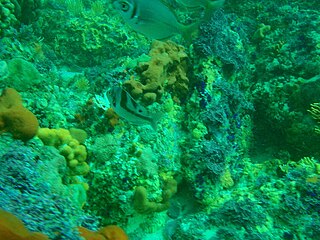
Chrysoblephus cristiceps, the daggerhead seabream or dageraad, is a species of marine ray-finned fish belonging to the family Sparidae, the seabreams and porgies. This fish is endemic to the southwestern Indian Ocean and southeastern Atlantic Ocean off South Africa. This species is assessed as being Critically Endangered bt the International Union for Conservation of Nature.
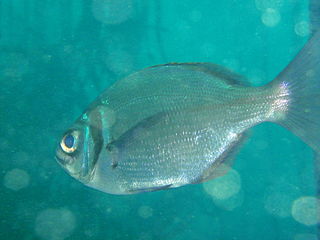
Booposoidea is a monospecific genus of marine ray-finned fish belonging to the family Sparidae, the seabreams and porgies. The only species in the genus is Boopsoidea inornata, the Fransmadam or Karel grootoog, which is endemic to the southwestern Indian Ocean off South Africa.
Argyrops filamentosus, the soldierbream, is a species of marine ray-finned fish belonging to the family Sparidae, the seabreams and porgies. This fish is found in the Western Indian Ocean.
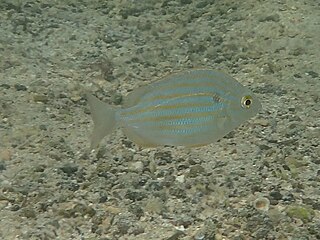
Archosargus pourtalesii, the blackspot porgy or Galápagos seabream, is a species of marine ray-finned fish belonging to the family Sparidae, the seabreams and porgies. This fish is endemic to the Galápagos Islands in the eastern Pacific Ocean.


















